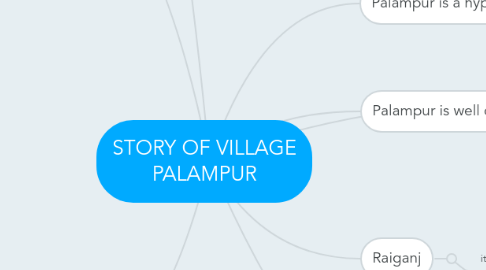
1. Non farming activities in Palampur
1.1. transport:a fast developing sector
1.1.1. there are variety of vehicles on the road connecting palampur to raiganj.
1.1.1.1. they ferry people and goods from one place to place.
1.2. the shopkeepers of palampur
1.2.1. people are not involved in trading in palampur.
1.2.1.1. the traders of palampur are shopkeepers who buy various goods from wholesale markets and they sell them in the village.
1.3. an example of small scale manufacturing in palampur
1.3.1. at present, less than fifty people are engaged in manufacturing in palampur.
1.3.1.1. unlike the manufacturing that takes place in the big factories in the towns and cities, manufacturing in palampur involves very simple production methods and are done on a small scale.
1.4. dairy-the other common activity
1.4.1. diary is a common activity in many families of palampur. people feed their buffalos on various kinds of grass and the jowar and bajra that grows during the rainy season.
1.4.1.1. the milk is sold in raiganj, the nearby large village.
2. Organisation of production
2.1. the aim of the production is to produce the goods and services that we want.
2.1.1. the third requirement is physical capital.
2.1.2. the second requirement is labour.
2.1.3. the first requirement is land and other natural resources such as water,forests,minerals.
2.1.3.1. and even human capital is also there.
2.1.3.2. raw materials and money in hand are working capital.
2.1.3.2.1. every production is organised by combining land,labour,physical capital,and human capital, which are known as factors of production.
2.1.3.3. tools,machines,buildings are fixed capital.
2.1.4. that are:
3. Farming and Palampur
3.1. is there a way one can grow more from the same land?
3.1.1. in the kind of crops grown and facilities available,palampur would resemble a village of the western part of the state of uttar pradesh.
3.1.1.1. all land is cultivated in palampur
3.1.1.1.1. the main reason why farmers are able to grow three different crops in a year in palampur is due to the well developed system of irrigation.
3.2. who will provide the labour?
3.2.1. after land, labour is the next necessary factor for production. farming requires a great deal of hard work. small farmers along with their families cultivate their own fields.
3.2.1.1. thus, they provide the labour required for farming themselves.
3.2.1.1.1. medium and large farmers hire farm labourers to work on thier fields.
3.3. how is land distributed between the farmers of palampur?
3.3.1. unfortunately,not all the people engaged in agriculture have sufficient land for cultivation.
3.3.1.1. in palampur about one third of the 450 families are landless,i.e. 150 families, most of them dalits, havve no land for cultivation.
3.4. scale of surplus farm products
3.4.1. let us suppose that the farmers have produced wheat on their lands using the three factors of production.
3.4.1.1. the wheat is harvested and production is complete.
3.4.1.1.1. small farmers like savitha and gobind 's sons have little surplus wheat because their total production is small and from this a sustainable share is kept for their own family needs.
3.5. will the land sustain?
3.5.1. land being a natural resource,it is necessary to be very careful in its use.
3.5.1.1. scientific reports indicate that the modern farming methods have overused the natural resource base.
3.6. the capital needed in farming.
3.6.1. we know that the modern farming methods require a great deal of capital, so that the farmer now needs more money than before
3.6.1.1. most small farmers have to borrow money to arrange for the capital.
3.6.1.1.1. in contrast to the small farmers, the medium and the large farmers have their own savings from farming.
3.7. land is fixed
3.7.1. farming is the main production activity in palampur.
3.7.1.1. 75 percent of the people who are working are dependent on farming for their livelihood.
3.7.1.1.1. they could be farmers or farm labours.
4. Palampur is a hypothetical village
4.1. this village has about 450 families belonging to several different castes
4.1.1. the 80 upper caste
4.1.1.1. they own the majority of land in the village
5. it is well connected with neighbouring villages and towns.
5.1. many of the houses have electric connections
5.1.1. Palampur has 2 primary schools and one high school.
5.1.1.1. there is a primary health care centre run by the government and one private dispensary where the sick are treated
6. Palampur is well connected
7. Raiganj
7.1. it is a big village,is 3kms from palampur
8. many kind of transport are visible on this road starting from bullock carts,tongas,bogeys, loaded with jaggery and other commodities to motor vehicles like motorcycles,jeeps,tractors and trucks.
8.1. this village has about 450 families belonging to several different castes.
8.1.1. the 80 upper caste families own the majority of land in the village
8.1.1.1. their houses,some of them are quite large,are made up of brick with cement plastering
